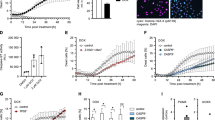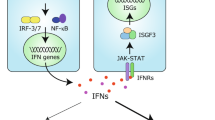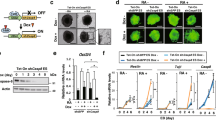Abstract
We have isolated a novel interferon (IFN)-retinoid regulated cell death regulatory protein genes associated with retinoid-IFN-induced mortality (GRIM)-19 earlier. To understand its mechanism of action, we have employed a yeast-two-hybrid screen and identified serine protease HtrA2 as its binding partner. GRIM-19 physically interacts with HtrA2 and augments cell death in an IFN/all-trans retinoic acid (RA)-dependent manner. In the presence of GRIM-19, the HtrA2-driven destruction of the antiapoptotic protein X-linked inhibitor of apoptosis (XIAP) is augmented. These interactions were disrupted by an human herpes virus-8 (HHV-8)-coded oncoprotein, vIRF1, and conferred resistance to IFN/RA-induced cell death. These data show a critical role of HtrA2 in a cytokine-induced cell death response for the first time and its inhibition by a viral protein.
This is a preview of subscription content, access via your institution
Access options
Subscribe to this journal
Receive 50 print issues and online access
$259.00 per year
only $5.18 per issue
Buy this article
- Purchase on Springer Link
- Instant access to full article PDF
Prices may be subject to local taxes which are calculated during checkout







Similar content being viewed by others
Abbreviations
- FL:
-
full length
- GFP:
-
green fluorescent protein
- GRIM:
-
genes associated with retinoid-IFN-induced mortality
- HHV8:
-
human herpesvirus 8
- Htr:
-
high-temperature-resistant
- IFN:
-
interferon
- NB:
-
Northern blot
- RA:
-
all-trans retinoic acid
- STAT:
-
signal transducing activator of transcription
- vIRF1:
-
viral interferon regulatory factor 1
- WB:
-
Western blot
- XIAP:
-
X-linked inhibitor of apoptosis
References
Altucci L, Gronemeyer H . (2001). The promise of retinoids to fight against cancer. Nat Rev Cancer 1: 181–193.
Angell JE, Lindner DJ, Shapiro PS, Hofmann ER, Kalvakolanu DV . (2000). Identification of GRIM-19, a novel cell death-regulatory gene induced by the interferon-beta and retinoic acid combination, using a genetic approach. J Biol Chem 275: 33416–33426.
Chomienne C, Barrellini P, Balitrand N, Daniel M, Fenaux P, Castaigne S et al. (1990). All trans retinoic acid as a differentiation therapy for acute promyelocytic leukemias I: clinical results. Blood 76: 1710–1717.
Dale TC, Imam AM, Kerr IM, Stark GR . (1989). Rapid activation by interferon alpha of a latent DNA-binding protein present in the cytoplasm of untreated cells. Proc Natl Acad Sci USA 86: 1203–1207.
Fearnley IM, Carroll J, Shannon RJ, Runswick MJ, Walker JE, Hirst J . (2001). GRIM-19, a cell death regulatory gene product, is a subunit of bovine mitochondrial NADH: Ubiquinone oxidoreductase (complex I). J Biol Chem 276: 38345–38348.
Gao SJ, Boshoff C, Jayachandra S, Weiss RA, Chang Y, Moore PS . (1997). KSHV ORF K9 (vIRF) is an oncogene which inhibits the interferon signaling pathway. Oncogene 15: 1979–1985.
Gresser I, Belardelli F . (2002). Endogenous type I interferons as a defense against tumors. Cytokine Growth Factor Rev 13: 111–118.
Gupta S, Singh R, Datta P, Zhang Z, Orr C, Lu Z et al. (2004). The C-terminal tail of presenilin regulates Omi/HtrA2 protease activity. J Biol Chem 279: 45844–45854.
Hegde R, Srinivasula SM, Zhang Z, Wassell R, Mukattash R, Cilenti L et al. (2002). Identification of Omi/HtrA2 as a mitochondrial apoptotic serine protease that disrupts inhibitor of apoptosis protein-caspase interaction. J Biol Chem 277: 432–438.
Hu J, Angell JE, Zhang J, Ma X, Seo T, Raha A et al. (2002). Characterization of monoclonal antibodies against GRIM-19, a novel IFN-beta and retinoic acid-activated regulator of cell death. J Interferon Cytokine Res 22: 1017–1026.
Ikeda H, Old LJ, Schreiber RD . (2002). The roles of IFNgamma in protection against tumor development and cancer immunoediting. Cytokine Growth Factor Rev 13: 95–109.
Jayachandra S, Low KG, Thlick AE, Yu J, Ling PD, Chang Y et al. (1999). Three unrelated viral transforming proteins (vIRF, EBNA2, and E1A) induce the MYC oncogene through the interferon-responsive PRF element by using different transcription coadaptors. Proc Natl Acad Sci USA 96: 11566–11571.
Jin S, Kalkum M, Overholtzer M, Stoffel A, Chait BT, Levine AJ . (2003). CIAP1 and the serine protease HTRA2 are involved in a novel p53-dependent apoptosis pathway in mammals. Genes Dev 17: 359–367.
Kalvakolanu DV . (2004). The GRIMs: a new interface between cell death regulation and interferon/retinoid induced growth suppression. Cytokine Growth Factor Rev 15: 169–194.
Kalvakolanu DV, Borden EC . (2002). Interferons: cellular and molecular biology of their actions. In: Bertino JR (ed). Encyclopedia of Cancer vol. II Academic Press: San Diego, CA, pp 511–521.
Kuninaka S, Nomura M, Hirota T, Iida S, Hara T, Honda S et al. (2005). The tumor suppressor WARTS activates the Omi/HtrA2-dependent pathway of cell death. Oncogene 24: 5287–5298.
Li W, Srinivasula SM, Chai J, Li P, Wu JW, Zhang Z et al. (2002). Structural insights into the pro-apoptotic function of mitochondrial serine protease HtrA2/Omi. Nat Struct Biol 9: 436–441.
Martins LM, Iaccarino I, Tenev T, Gschmeissner S, Totty NF, Lemoine NR et al. (2002). The serine protease Omi/HtrA2 regulates apoptosis by binding XIAP through a reaper-like motif. J Biol Chem 277: 439–444.
Seo T, Lee D, Shim YS, Angell JE, Chidambaram NV, Kalvakolanu DV et al. (2002). viral interferon regulatory factor 1 of Kaposi's sarcoma-associated herpesvirus interacts with a cell death regulator, GRIM19, and inhibits interferon/retinoic acid-induced cell death. J Virol 76: 8797–8807.
Shankaran V, Ikeda H, Bruce AT, White JM, Swanson PE, Old LJ et al. (2001). IFNgamma and lymphocytes prevent primary tumour development and shape tumour immunogenicity. Nature 410: 1107–1111.
Stennicke HR, Deveraux QL, Humke EW, Reed JC, Dixit VM, Salvesen GS . (1999). Caspase-9 can be activated without proteolytic processing. J Biol Chem 274: 8359–8362.
Suzuki Y, Imai Y, Nakayama H, Takahashi K, Takio K, Takahashi R . (2001). A serine protease, HtrA2, is released from the mitochondria and interacts with XIAP, inducing cell death. Mol Cell 8: 613–621.
van Loo G, van Gurp M, Depuydt B, Srinivasula SM, Rodriguez I, Alnemri ES et al. (2002). The serine protease Omi/HtrA2 is released from mitochondria during apoptosis. Omi interacts with caspase-inhibitor XIAP and induces enhanced caspase activity. Cell Death Differ 9: 20–26.
Vander Heiden MG, Chandel NS, Williamson EK, Schumacker PT, Thompson CB . (1997). Bcl-xL regulates the membrane potential and volume homeostasis of mitochondria. Cell 91: 627–637.
Vaux DL, Silke J . (2003). Mammalian mitochondrial IAP binding proteins. Biochem Biophys Res Commun 304: 499–504.
Yang QH, Church-Hajduk R, Ren J, Newton ML, Du C . (2003). Omi/HtrA2 catalytic cleavage of inhibitor of apoptosis (IAP) irreversibly inactivates IAPs and facilitates caspase activity in apoptosis. Genes Dev 17: 1487–1496.
Zhang J, Yang J, Roy SK, Tininini S, Hu J, Bromberg JF et al. (2003). The cell death regulator GRIM-19 is an inhibitor of signal transducer and activator of transcription 3. Proc Natl Acad Sci USA 100: 9342–9347.
Zimring JC, Goodbourn S, Offermann MK . (1998). Human herpesvirus 8 encodes an interferon regulatory factor (IRF) homolog that represses IRF-1-mediated transcription. J Virol 72: 701–707.
Acknowledgements
DVK thanks National Cancer Institute for grant support CA105005. We also thank Patrick Moore, Emad Alnemri and Margaret Offerman for providing the reagents used in this study.
Author information
Authors and Affiliations
Corresponding author
Additional information
Supplementary Information accompanies the paper on the Oncogene website (http://www.nature.com/onc).
Supplementary information
Rights and permissions
About this article
Cite this article
Ma, X., Kalakonda, S., Srinivasula, S. et al. GRIM-19 associates with the serine protease HtrA2 for promoting cell death. Oncogene 26, 4842–4849 (2007). https://doi.org/10.1038/sj.onc.1210287
Received:
Revised:
Accepted:
Published:
Issue Date:
DOI: https://doi.org/10.1038/sj.onc.1210287
Keywords
This article is cited by
-
Protease-independent control of parthanatos by HtrA2/Omi
Cellular and Molecular Life Sciences (2023)
-
The cell death regulator GRIM-19 is involved in HIV-1 induced T-cell apoptosis
Apoptosis (2010)
-
Mitochondrial respiratory dysfunction and mutations in mitochondrial DNA in PINK1 familial Parkinsonism
Journal of Bioenergetics and Biomembranes (2009)
-
The mitochondrial serine protease HtrA2/Omi: an overview
Cell Death & Differentiation (2008)
-
Construction of recombinant adenovirus carrying GRIM19 and its effect on SW480 cells
Journal of Huazhong University of Science and Technology [Medical Sciences] (2008)



